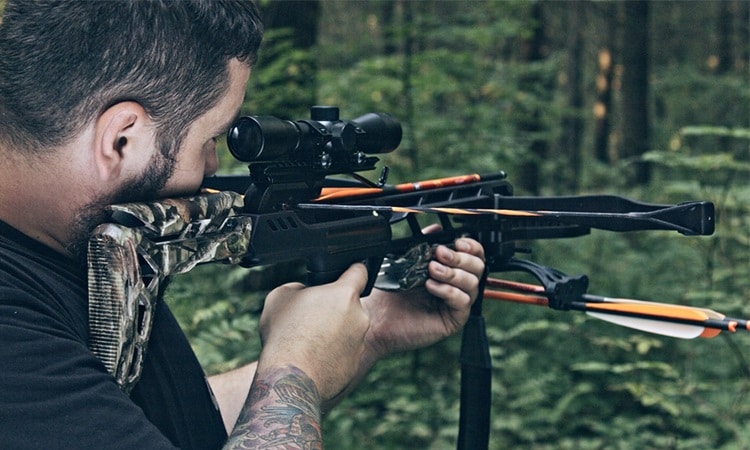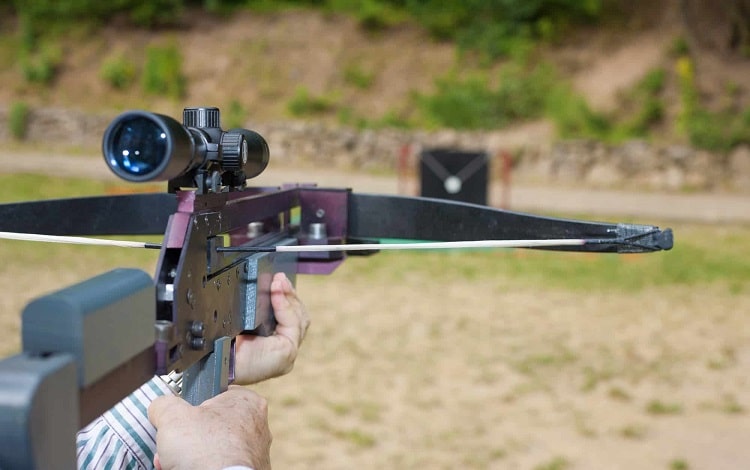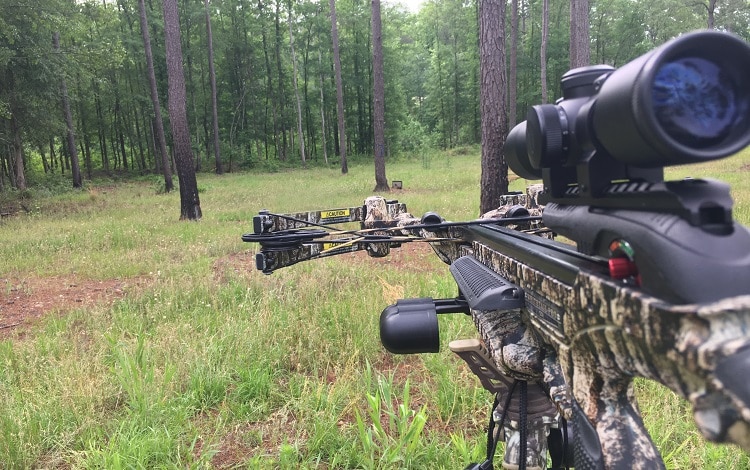You have a high powered crossbow, top-of-the-line bolts, and a brand new multi layer scope that’s going to take your hunting game to the next level.
That is, if you can align your sight properly. A misaligned sight can take your otherwise perfect aim, and throw a wrench in the gears.
This is how to sight in a crossbow properly for more accurate shots. Whether you just bought a new sight or you need to realign a pre-owned one, this is what you need to know.
Can You Use Any Scope on a Crossbow?

Yes you can, but there are some caveats. If you want to take a pistol reflex sight or a rifle scope and slap it on your crossbow, you have that option. But these guns don’t account for drop, which is something you8 have to worry about with your crossbow.
Because some crossbows can effectively land shots from 300-500 yards away, and I doubt you’ll be trying to land a perfect kill on a whitetail from this distance, you can use these sights with little to no issues.
But they don’t have the same benefits as multilayer crossbow scopes. For one, they don’t have the same drop lines that you get with a crossbow scope, so you run into some logistics issues when lining up your shots.
On top of that, compatibility is a big issue as well. Rifle scopes only really list their compatibility with other rifles, so there’s usually not a lot of information if it’ll fit your crossbow or not. With a crossbow-specific scope, you get upfront information and compatibility matches so that you don’t wait for a scope to arrive just to ship it back.
Drop lines, compatibility, and weight are the biggest issues. Crossbow sights are usually lighter than rifle scopes, so you save on carry weight and don’t have as much forward-facing drag.
How to Sight in a Crossbow Scope?

Now it’s time to learn how to actually sight your crossbow. You can use the instructions here for the multi reticle scope and Barnett 4×32 scope, and apply that knowledge to other scopes as well.
How to Sight in a Multi Reticle Crossbow Scope?
Multi line, multi reticle, drop-compensating scope—whatever you want to call it. These do most of the work for you once you get proper alignment. This is what you need to do.
- Determine how close you plan on getting to your prey. You need to have some sense of proper distance measuring to know this, but most hunters are around the 30 yard to 50 yard mark. Find yours to continue.
- Set your top line to ten yards fewer than your maximum expected shooting range. If you think that you may shoot up to 50 yards, set the top line to 40 yards.
- Your second line should self-correct, but we want to be sure about this. Test fire your crossbow to a target at your preferred total range to see if the top line is accurate. If so, fire using the second line and see if the results stick. If so, your lower lines should also feel pretty responsive.
- If your lines are set up, but you’re still missing your mark, it could be a calibration issue. Every sight has its own calibration instructions in the packaging, so be sure to check this out. While many scopes come pre-calibrated, there’s a dozen different shipping-related reasons as to why it might have come undone.
- Adjust windage and elevation settings as needed. In most scopes, a minor tweak goes a long way. Do this if you need to, then recheck your top line with a test shot. If that’s on-par, the others should be as well, though it can’t hurt to try them out again just to verify the results.
How to Sight in a Barnett 4×32 Crossbow Scope?

Barnett’s 4×32 scopes are some of the most popular solutions for crossbow hunters and rifle hunters as well, so we put together specific calibration and sighting instructions for their 4×32 lineup.
- Check the top of the scope. You’ll see a knob that adjusts the red and/or green for the dot sight. Adjust this by brightness levels depending on the visibility you currently have, or what the weather conditions are when you normally hunt.
- On the top of the scope, there’s a windage and elevation knob. You may have to use a screwdriver to adjust this accordingly. Every adjustment knob click is equivalent to ¼ MOA.
- Using the settings that we just discussed, line up your single dot for a 20 yard distance. Aim down the sight directly at the bullseye ahead of you, and take a test shot. You will likely not hit the bullseye right away, but this gives you a clear indication of what windage and elevation adjustments you need to make.
- Line up a shot, make your adjustments, and repeat the process. Set at 20 yards, you should be able to hit a bullseye with little to no errors from the sight.
Barnett scopes allow for some serious accuracy, although the red/green dot sights can be difficult to use during the day. Be sure that you have perfect visibility through the scope before you start scrutinizing calibrations so you don’t make unnecessary adjustments.
What Distance Should You Sight in a Crossbow?
It depends on what you’re hunting and what scope you’re using. These are the two main types of scopes you’ll encounter, and this is what distance you should use for each.
Red Dot Sight
You have one dot, so you’d better get it right. In some ways, hitting your target when using a red dot can be more difficult than using a multilayer drop line sight, because you have no frame of reference.
WIth a multilayer drop line sight, you have options. With red dots, you have to be pretty good at determining your distance from the target to ensure your aim will be true. You should aim your red dot sight to whichever distance best suits what you’re hunting. For whitetail, 40 yards. For smaller game, 20–30 yards.
Multilayer Drop Line Sight
Multilayer sights take more time to get it right, but you have so many options available to you. The great thing here is that you only have to worry about the top line or dot, because everything else falls into place.
More information will be available in the manual that came with your sight, but most lines are designed to have a difference of 20 yards compared to the line below it. If you set your main line/dot at 100 yards, the next line should be automatically set to 80 yards, and so on. The more lines, the more sight options you have available.
Again, this is going to depend on the manufacturer and what sight you have, because some lines are set up with different spacing. For these, setting your main line to 20 yards is your best option, because even a three-line will set you up to 60 yards, which is usually the furthest than anyone that isn’t a hardocre experienced hunter should be from their target.
How Far Can You Kill a Deer With a Crossbow?

This is up for debate for a few reasons, and those are all variables that directly affect your shot.
No your ability to shoot, but what happens to your bolt as it leaves your crossbow.
You can be on-point with aiming and have excellent shooting posture, you can do everything right, but there are more forces at play. Wind speed, direction, if you have high ground or not, the grain weight of your bolts, and so much more.
It’s safe to assume that with an 80 lb draw weight and at least 300+ FPS, you can kill a fully grown male whitetail deer in summer with one bolt from up to 40 yards away. After a certain point, momentum dropoff begins to affect you.
With the right scope and tons of experience, you can kill a deer from 100 yards away, but there are so many more opportunities for things to go wrong. You run the chance of just injuring the deer, but with the stopping power from 40 yards away, one good shot is all it takes.
Sighting a Crossbow the Right Way
For multi-layer sights and red dots alike, sighting your crossbow will set up any additional distance lines for success.
Once you get the hang of it, you’ll be sighting crossbows in your sleep with maximum effectiveness. If your sight isn’t aligned properly, your shots won’t add up.
Take the time to make sure you did everything properly, and maybe make some 20 yard and 40 yard test shots at a bullseye (in ideal weather conditions) to get some accurate feedback on how well you sighted your crossbow.


